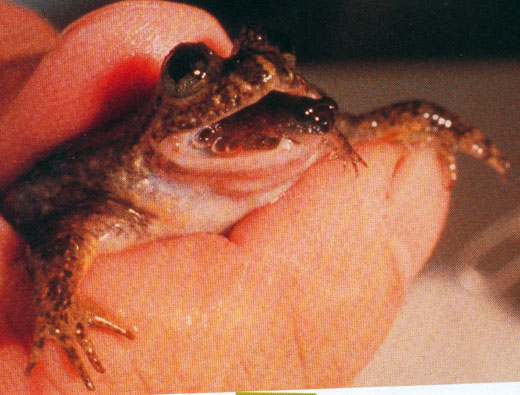
Southern gastric-brooding frog
Rheobatrachus silus


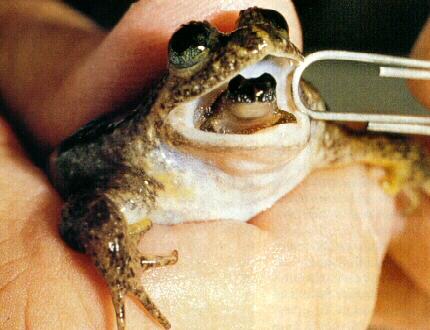
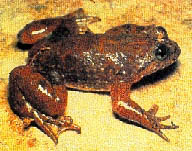
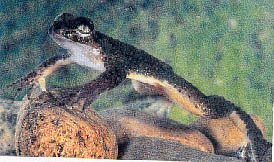
Queensland Legislative Status: Endangered
Endemicity: Queensland Endemic
Description: A moderately large, aquatic frog, males 30-44mm,
females 41-54mm (Ingram 1983, Tyler & Davies 1983a). Dorsal
surface is brown, or olive brown to almost black, usually with
obscure darker blotches on the back. A dark streak runs from the
eye to base of the forelimb. There are darker cross-bars on the
limbs, and pale and dark blotches and variegations on the digits
and webbing. Ventral surface is white or cream with yellow
markings on limbs. Skin is shagrened or finely granular above,
and smooth below. Snout is blunt and rounded, with the eyes and
nostrils directed upwards. Eyes are large and prominent, located
close together and close to front of head. Tongue is largely
adherent to the floor of mouth. Typanum is hidden. Fingers lack
webbing, while toes are fully webbed. Digits have small discs.
(Cogger 2000, Liem 1973, Tyler & Davies 1983a).
Call: Call is a loud staccato, consisting of 30-34 pulses repeated
in a long series, lasting 260-290 min/s. Dominant frequency is
1000 Hz, with less emphasises frequency bands at
500,700,1200 and 1400 Hz (Tyler 1983b).
Tadpole: Unknown
Reproduction: Breeding activity occurs between October and
December and appears dependent on summer rains (Ingram
1983). This species features a unique reproductive mode in
which eggs or early larvae are swallowed by the female and
complete their development in the stomach (Tyler & Carter 1982).
Hormones produced by the young inhibit the digestive secretions
of the stomach and inactivate the upper intestine, a process of
special interest to the medical community (Tyler 1984). Larvae
rely on yolk reserves throughout development (Tyler & Davies
1983b). Up to 25 young are brooded in this fashion, emerging
from the mother's mouth as fully formed metamorphs about 6-7
weeks (Tyler & Davies 1983b). the digestive tract returns to its
normal state and the female recommences feeding within four
days (Tyler 1983a). Maximum longevity is at least 3 years (Ingram
1983).
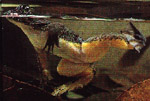
Habitat: Rheobatrchus silus is an aquatic species and has
never been located more than 4m from water. This species is
restricted to rocky perennial streams, soaks and pools in
rainforest and tall open forest with a closed understorey. It prefers
rock pools and backwaters with leaf litter and rocks in which to
shelter (Ingram 1983).
Rheobatrachus silus is most active during the warmer months,
between September and April, abundance decreasing as
conditions become drier in winter (Ingram 1983). It is not known
where these individuals go during this period, but it is believed
they hibernate in deep crevices in the rocks (Ingram 1983, Liem
1973, McDonald pers obs). Individuals may be active night or
day, particularly after rain. They establish home ranges in and
around suitable pools, spending extended periods partly
submerged and immobile. When heavy rain falls the males move
away from the water, sometimes up to four metres, and call from
sheltered hollows or crevices above the pools (Ingram 1983).
Distribution: Rheobatrachus silus is restricted to elevations of
400-800m in the Blackall and Conondale Ranges, south-eastern
Queensland. Rheobatrachus silus has not been sighted in the
wild since 1981 and may be extinct. Continued efforts to relocate
the species have failed (Hines et al.1999).
Latitude: Between 26º 34' and 27º 47';
Longitude: Between 152º 32' and 152º 53'.
Status: R. silus is one of five species of upland rainforest
stream-dwelling frogs which has declined in south-eastern
Queensland during the last 18 yrs (Ingram & McDonald 1993).
The species underwent an unanticipated decline in winter 1979
(Tyler & Davies 1985, Czechura & Ingram 1990) and the last
sighting occurred September 1981 (Richards et.al. 1993).
Searches have continued unsuccessfully, most recently in
November 1999 (Ingram & McDonald 1993, H. Hines pers
comm). Last known specimen died in captivity November 1983
(Tyler & Davies 1985).
Threatening Processes: The causes of the population decline
remain unknown. Tyler & Davies (1985) found no obvious
evidence that over collecting, pollution from logging or gold
panning, or drought were responsible for the population decline.
Current research is examining the possibility that a fungus may
have caused the decline of this species (Berger et al 1998,
Berger et al 1999). Information on disease investigations and
management can be located at
http://www.jcu.edu.au/school/phtm/PHTM/frogs/ampdis.htm.
The Gastric-Brooding Frog (Rheobatrachus silus) is an Australian casualty. It was only discovered 25 years ago in 1973. It is probably extinct already! This frog is unique. The female lays her eggs and swallows them so the tadpoles develop in her stomach. After 6 weeks about 25 young froglets are "born" through their mother's mouth as perfectly formed miniature frogs. While the tadpoles are growing in her stomach their mother shuts down her digestive juices and she doesn't eat. She is so full of tadpoles that her lungs don't have room to work so she absorbs oxygen through her skin. A week after her babies are born she starts to eat again. These frogs are olive-brown, almost black, with dark patches on the back, a whitish belly and some bright orange on their limbs. The males are 4 cms long and the females are 5 cms. Their fingers are long and slender, pointed and unwebbed and their toes are fully webbed. Gastric-brooding frogs feed at night by catching beetles, flies, mosquitoes and other insects with their long broad tongue. They live beside rocky mountain streams in eucalypt forests, hiding under rocks during the day and sitting on them, partly submerged at night. They are strong swimmers but will also drift in the water and sometimes float on their backs. Not you usual frog! Found only in a few mountain streams in the Blackall and Conondale Ranges of south-east Queensland, these frogs have not been seen in the wild since 1980. The last captive Rheobatrachus silus Gastric-Brooding Frog died at the Department of Zoology at the University of Adelaide in 1983, where it had been kept for research for 5 years. Two months after it died, another species of Gastric-Brooding Frog Rheobatrachus Vitellinus was discovered 800kms to the north. This one is bright yellowish-orange on the belly and under the arms, is pale brown, slightly larger than the other one and lives in fast, flowing creeks near the boundary of the Eungella National Park. It has not been seen in the wild since soon after its discovery. (Information from Taronga Zoo Education leaflets: GENERAL INFORMATION ON TWELVE AUSTRALIAN ENDANGERED SPECIES ----ENDANGERED NOW...EXTINCT FOREVER)
Source: http://www.env.qld.gov.au/cgi-bin/w3-msql/environment/plant/animals/resultframe.html?id=74
96 page booklet about disappearing Australian Frogs at http://www.ea.gov.au/biodiversity/threatened/information/frogs/pubs/frogs.pdf
For additional information, why not look up this book or CD:
http://www.naturesound.com.au/frogsse.htm The frog calls on this compact disc cover nearly all species in subtropical eastern Australia.
http://www.entosupplies.com.au/Books/Zoology/Reptiles_Amphibians/BT14Cthere.htm
There's a Frog in my Stomach / Tyler, M.J.
An easy reading, non-technical account of the Gastric Brooding Frog of Southeast
Queensland known to
brood its young in its stomach.